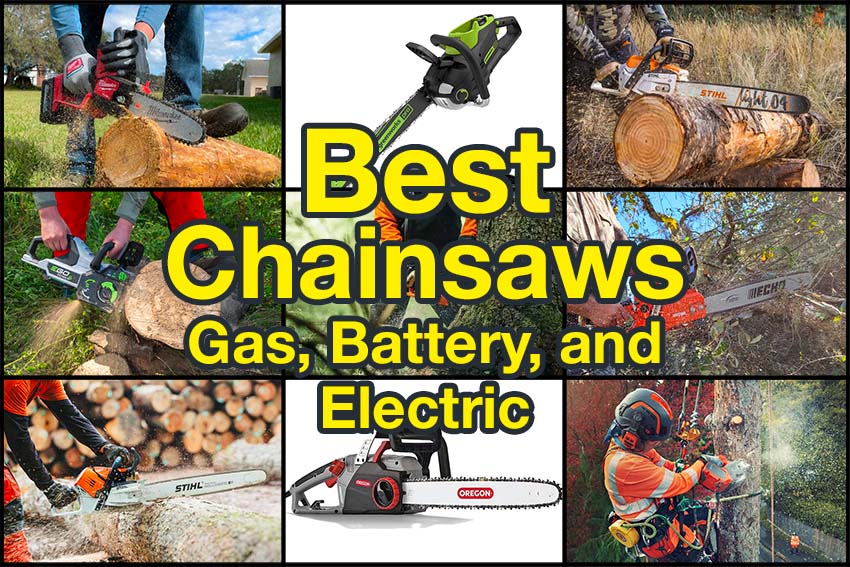Looking for the best chainsaw this year? You’ve come to the right place! Our team of experts got together to offer our recommendations for chainsaws from the best brands for both professional use and home use.
Our Top Picks
- Best Gas for Pros: Stihl MS 500I – Find a Dealer
Jump to this Chainsaw ↓ - Best Gas for the Money: ECHO CS501P – $499.99 at Home Depot
Jump to this Chainsaw ↓ - Best Gas for Home: ECHO CS-310 – $219.99 at Acme Tools
Jump to this Chainsaw ↓ - Best Battery for Pros: Stihl MSA 300 C-O – Find a Dealer
Jump to this Chainsaw ↓ - Best Battery for the Money: EGO 56V CS1611 – $299.00 at Acme Tools
Jump to this Chainsaw ↓ - Best Battery for Home: Greenworks 60V CS60L810 – $499.99 at Greenworks
Jump to this Chainsaw ↓ - Best Electric for Home: Oregon CS1500 – $114.99 at Amazon
Jump to this Chainsaw ↓ - Best Electric for the Money: Oregon CS1400 – $99.99 at Amazon
Jump to this Chainsaw ↓ - Best Gas Top Handle: ECHO CS2511T – $469.99 at Acme Tools
Jump to this Chainsaw ↓ - Best Battery Top Handle: Husqvarna T540i XP – $1069.99 at Acme Tools
Jump to this Chainsaw ↓ - Best Mini Chainsaw: Milwaukee M18 Fuel 3004 – $279.00 at Home Depot
Jump to this Chainsaw ↓
Best Gas Chainsaw for Professional Use
Stihl MS 500I Chainsaw
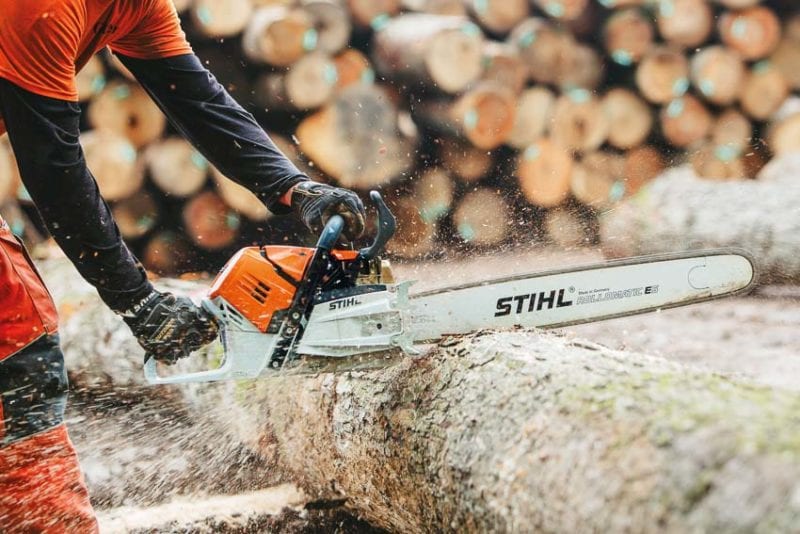
Competition for the best gas chainsaw for professionals is fierce and we whittled an impressive list down to three finalists: the ECHO CS-7130P, the Husqvarna 390 XP, and the Stihl MS 500I. Each of these chainsaws has outstanding power and the ability to run bars over 30 inches long.
Stihl earns the win thanks to an electronic fuel injection system that has proven reliable in the field and a lower dry weight than its two competitors above. While we’re confident that all three of these saws will keep Pros productive, we believe Stihl’s MS 500I is the best of the best.
Key Highlights
- Engine: 79.2 cc
- Bar length: 16 – 36 in
- Powerhead weight: 13.9 lbs
- Anti-vibration system
- Adjustable automatic oiling
- Ematic bar/Oilomatic chain compatible
- Sensor-controlled fuel metering
- Retained fuel and oil caps
- Elastostart
- MGD1 diagnostic software
Price: Starting at $1549.99
Best Gas Chainsaw for the Money
ECHO CS-501P Chainsaw
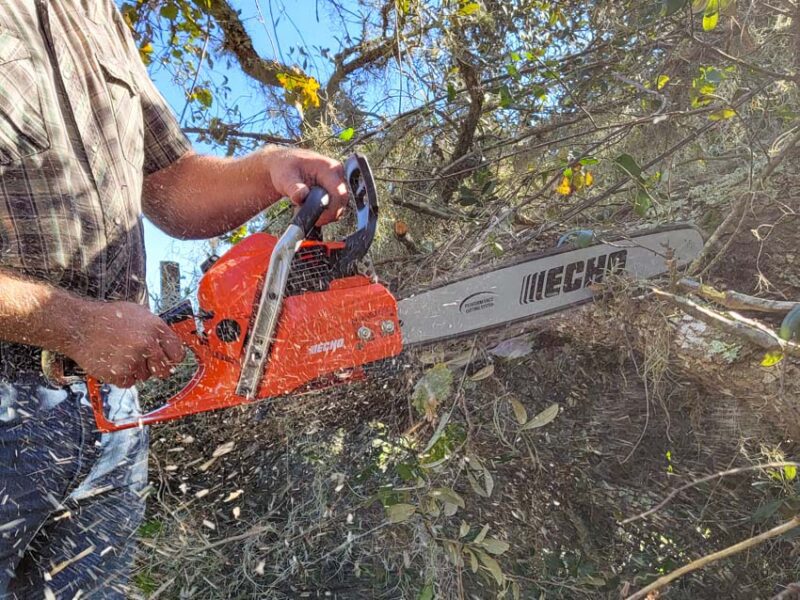
To get the best gas chainsaw for the money, we have to bleed off some power and a few features, but we don’t want to sacrifice reliability. We also want to keep the price tag around $500. Sticking with our top professional brands, that pits ECHO’s CS-501P, Husqvarna’s 455 Rancher, and Sithl’s MS 271 Farm Boss against each other.
Each of them is capable of cutting with a 20-inch bar and fits into the Farm and Ranch class. Husqvarna has an edge in overall power, but it’s ECHO’s CS-501P that is our top choice in this class. You’re only giving up about 5 cc on the engine and your reward is a saw that’s a whopping 2.6 pounds lighter.
Key Highlights
- Engine: 50.2 cc
- Bar length: 16 – 20 in
- Powerhead weight: 10.8 lbs
- Captive bar nuts
- Clutch-driven automatic oiler
- Decompression valve
- G-Force filter pre-cleaner
- Vibration reduction system
Price: $499.99 – $519.99
Best Gas Chainsaw for Home Use
ECHO CS-310 Chainsaw
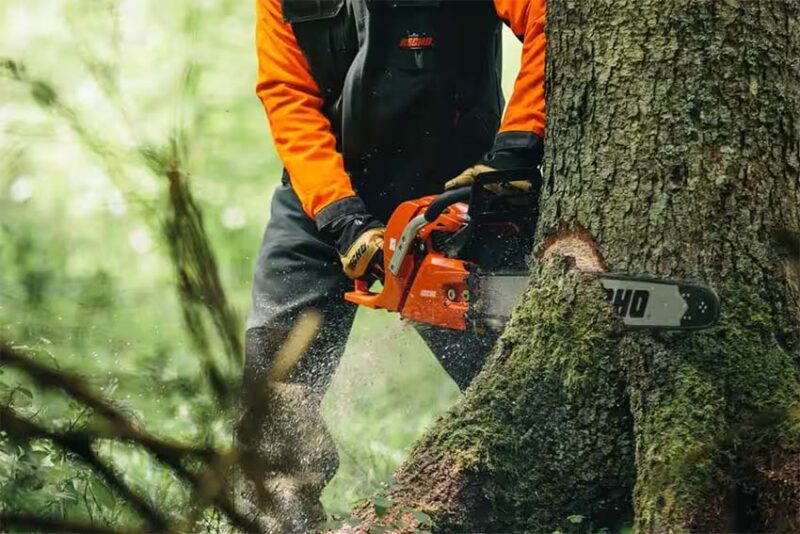
While homeowners have more brands to choose from, there are some excellent options from the Big 3 in the $200 – $250 range that we believe are a better bang for your buck. ECHO’s CS-310, Husqvarna’s 120, and Stihl’s MS 170 are all popular choices with excellent performance and reliability for homeowners that need an occasional-use chainsaw.
The final tally ended up between ECHO’s lighter weight and Husqvarna’s stronger performance. When it comes to the best gas chainsaw for home use, we like the lighter option, making the ECHO CS-310 our top choice in this category.
Key Highlights
- Engine: 30.5 cc
- Bar Length: 14 – 16 in
- Powerhead weight: 8.8 lbs
- i-30 starting system
- Clutch-drive automatic oiler
- Vibration reduction system
Price: $219.99
Best Battery-Powered Chainsaw for Professional Use
Stihl 36V MSA 300 C-O Chainsaw
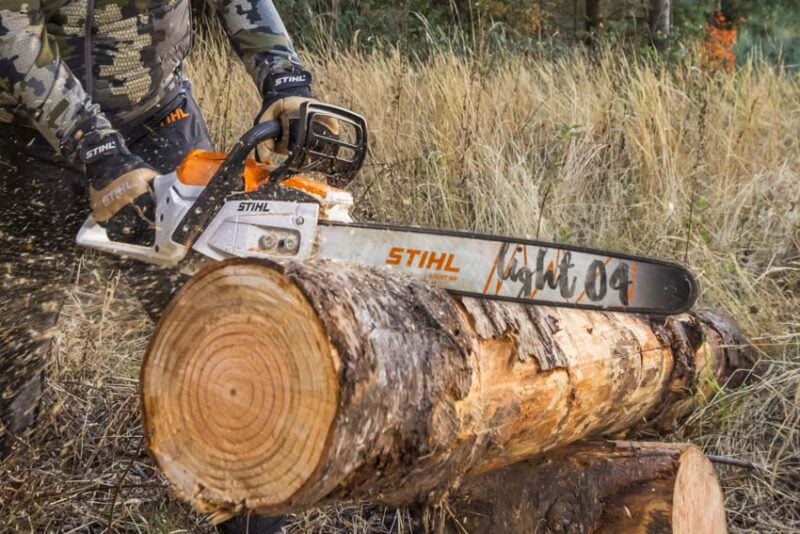
When it comes to choosing the best battery-powered chainsaw for professional use, we see the theme of three models separating themselves from the competition continue. This time, we add some new brands to the mix, though. DeWalt, Greenworks Commercial, and Stihl all came out with legit battery-powered Farm and Ranch class 20-inch chainsaws with performance that leaves everything else in their wake.
Stihl earns our vote as the top choice in this class, with 3 performance settings so you have options when you want to prioritize runtime over power. It has an LED screen that displays power status, mode, the chain brake position, and has a low oil alert. For those of you managing inventory, it’s also Connected 2 A compatible.
Stihl also introduced the AP 500 S battery along with the saw, giving the MSA 300 C-O an advanced power source to pull its high performance from.
Key Highlights
- Motor: brushless
- Bar length: 16 – 20 in
- Weight: 9.9 lbs (powerhead only), 14.1 lbs (with AP 500 S battery)
- Low oil sensor
- Electronic operating system with 3 mode selections
- Captive bar nuts
- Magnesium motor housing
- Ematic bar/Oilomatic chain compatible
- Quickstop chain brake
Price: Starting at $799.99 bare (prices may vary)
Best Battery-Powered Chainsaw for the Money
EGO 56V CS1611 Chainsaw
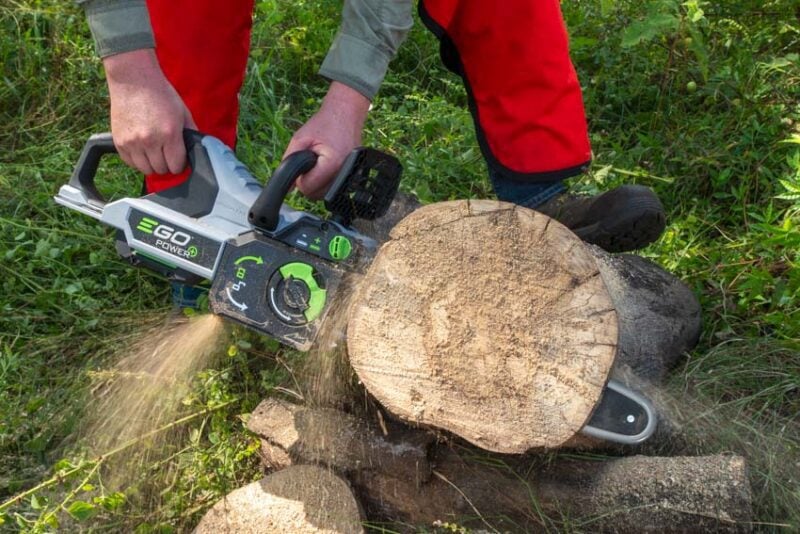
While EGO doesn’t have a 20-inch chainsaw (yet), its 14, 16, and 18-inch models are the best in their respective classes. Compared to the 20-inch models above, you can save $100 by moving to EGO’s 18-inch model, but you can save even more by going with the 16-inch CS1611 kit.
For most homeowners, a 16-inch chainsaw is a sweet spot between performance, size, weight, capacity, and cost. In EGO’s case, its 40cc gas equivalent performance comes with some fantastic ease-of-use features such as tool-free chain tensioning and metal bucking spikes.
Considering we’re talking about the best battery-powered chainsaw for the money, it’s the price that seals the deal. As a bare tool, this model is $249. You get the best value from the kit, though. It includes the saw, a 2.5Ah battery, and a charger for $299.
Key Highlights
- Motor: brushless
- Bar length: 16 in
- Powerhead weight: 8.7 lbs
- Tool-free chainsaw adjustment
- Flip-top oil cap
- Automatic oiler
- Intertia-activated chain brake
Price: $249.00 bare, $299.00 kit with a 2.5Ah battery and charger
Best Battery-Powered Chainsaw for Home Use
Greenworks 60V CS60L810 Chainsaw
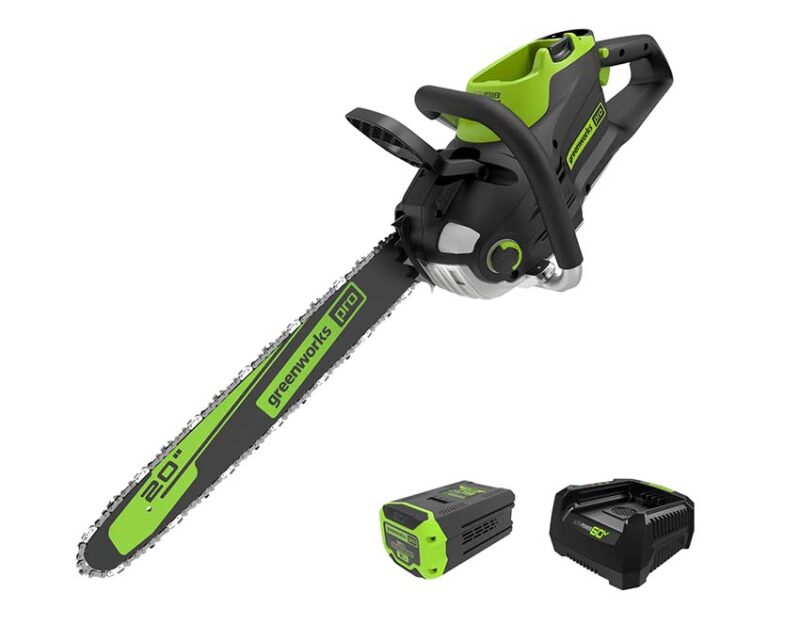
Greenworks and Ryobi both introduced 20-inch battery-powered chainsaws that reach into the Farm and Ranch class in 2023. Between the two, it’s the Greenworks 60V CS60L810 that earns our pick as the best battery-powered chainsaw for homeowners.
Both saws are outstanding performers in this class, but Greenworks digs deeper and offers higher performance with more torque and faster cutting than a 60 cc gas engine. For a residential chainsaw, that’s impressive work! What you won’t find on this model are a lot of electronic bells and whistles outside of what’s required to operate the chain and protect the motor/battery system.
While this saw is capable of operating using any of Greenworks’ 60V batteries, we highly recommend grabbing the kit that includes an 8.0Ah battery. This offers high enough runtime to get a lot of work done without having to stop and swap batteries or recharge.
Key Highlights
- Motor: brushless
- Bar length: 20 in
- Bare weight: 12.4 lbs
- Automatic chain oiler
- Interia-activated chain brake
Price: $499.99 kit with an 8.0Ah battery and charger
Best Electric Chainsaw for Home Use
Oregon CS1500 Chainsaw
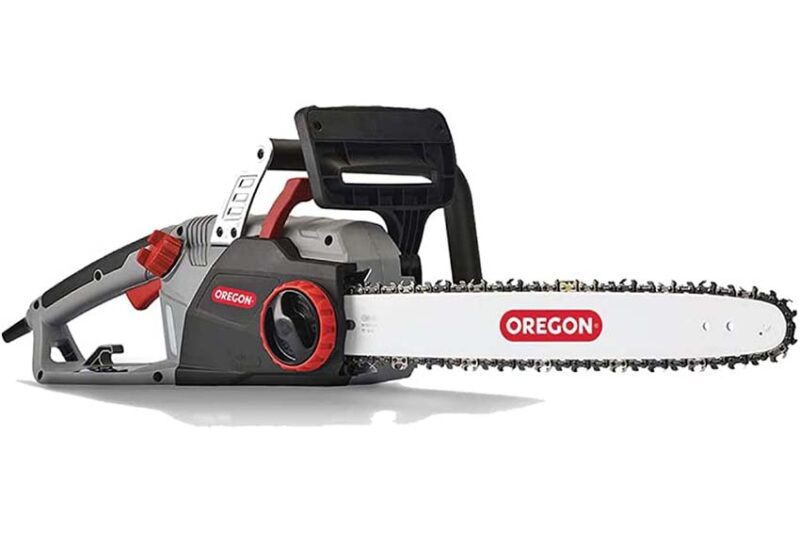
While electric chainsaws require you to drag around a cord, there are no gas hassles, no batteries to charge, and they’re a heck of a lot less expensive. Pulling 15 amps and sporting an 18-inch bar, the Oregon CS1500 chainsaw is our choice as the best electric chainsaw for home use. Not only does it have strong performance, but it also has a built-in chain sharpener you won’t find on other models.
Key Highlights
- Motor: 15-amp
- Bar length: 18 in
- Weight: 15 lbs
- PowerSharp built-in chain sharpener
- Automatic oiler
- Tool-free chain tensioner
- Intertia-activated chain brake
Price: $114.99
Best Electric Chainsaw for the Money
Oregon CS1400 Chainsaw
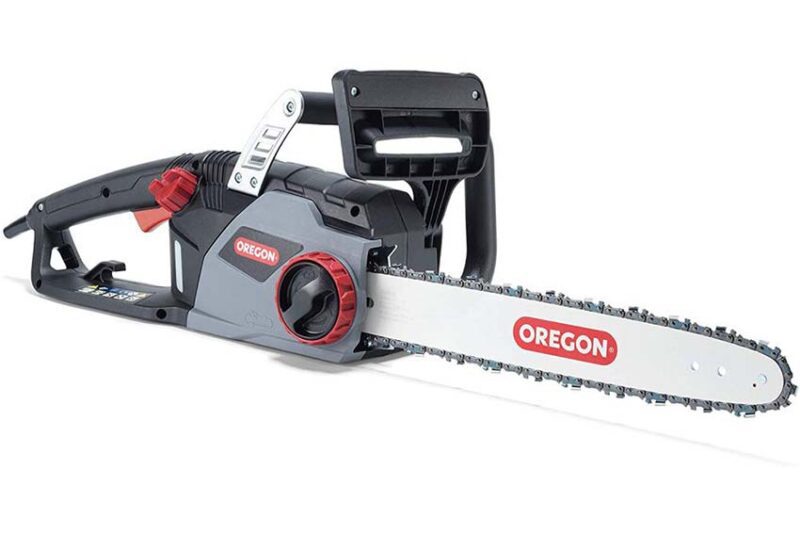
If you need to keep the price under $100 for an electric chainsaw, Oregon earns our vote in this category as well. The main things you give up compared to the CS1500 are the built-in chain sharpener and you drop to a 16-inch bar. You still get 15 amps of power, though, so the performance is going to be higher than you see on the budget chainsaws that only have 9 or 10-amp motors.
Key Highlights
- Motor: 15-amp
- Bar length: 16 in
- Weight: 12.9 lbs
- Automatic oiler
- Tool-free chain tensioner
- Intertia-activated chain brake
Price: $99.99
Best Chainsaw Brands
For professionals, three chainsaw brands dominate the market: ECHO, Husqvarna, and Stihl. All three have battery-powered options, but it’s the gas saws that still run the show at the moment. Perhaps not as popular, Makita also makes a quality chainsaw, though they’ve exited the gas sector and are relying on the strength of the 18V LXT and 40V XGT battery systems. Milwaukee’s chainsaw line isn’t a broad, but we currently have their standard, top-handle, and Hatchet pruner models from the M18 Fuel line all in service with our crew.
For homeowners, there are a lot more options. The same ECHO, Stihl, and Husqvarna also have models priced for homeowners. Add in battery-powered options from EGO’s 56V system, Greenworks 60V and Commercial 82V platforms, and Ryobi’s 40V line, and you have several solid brands to choose from.
Those certainly aren’t the only brands we recommend, but if you’re looking for a place to start, there are the best chainsaw brands to look at.
Best Top-Handle Chainsaws
Gas: ECHO CS2511T Top Handle Chainsaw
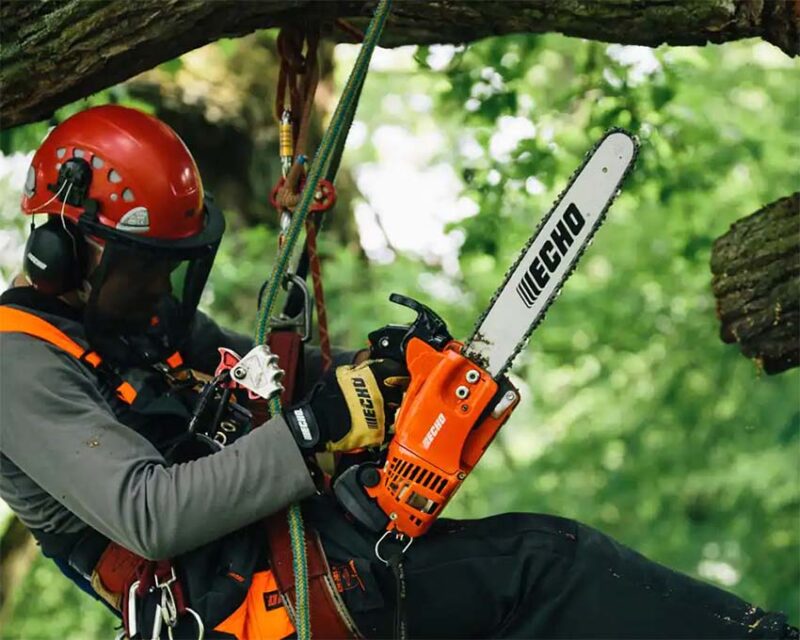
Top-handle chainsaws are specially designed for arborists who need to make cuts in less-than-ideal circumstances and often while climbing or in a bucket. For those scenarios, we’re willing to give up a little on the performance side to get a lighter-weight tool. ECHO’s CS2511T and CS2511TN (same saw with an 80TXL cutting system) take lightweight to the extreme. Sporting a 25cc engine, the dry weight is a ridiculously light 5.2 pounds. You could get a more powerful saw, but you won’t be anywhere near that low of a weight.
Key Highlights
- Engine: 25cc
- Bar length: 12 – 14 in
- Dry weight: 5.2 pounds
- G-Force air pre-cleaner
- 80TXL low-vibration cutting system (CS2511TN model)
- Clutch-driven automatic oiler
- Dual-post chain brake
Price: $459.99 – $469.99
Battery: Husqvarna T540i XP Top Handle Chainsaw
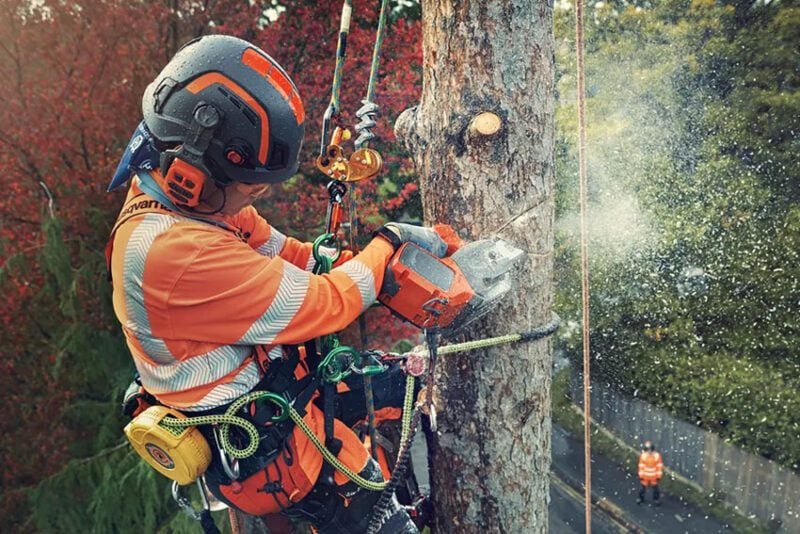
If you want to make the change to battery power, the best cordless top-handle chainsaw currently available is Husqvarna’s T540i XP in our opinion. Stronger than Echo’s 56V DCS2500T, its balance of 40cc power, weight, and 12 – 16-inch bar options make it an excellent choice for arborists.
While Echo takes the cake as the lightest professional choice, Husqvarna does have the option to use a backpack battery and shift some of the battery weight off of the saw. It’s not terribly practical when you’re climbing, but can be handy for ground-level work.
Key Highlights
- Motor: brushless
- Bar length: 12 – 16 in
- Powerhead weight: 5.5 lbs
- Integrated Husqvarna Connect
- Adjustable oil pump
- 3-minute auto shutdown when not in use
- Eco mode
- Retained bar nuts
- Flip-up oil cap
- Inertia-activated chain brake
Price: Starting at $629.99 bare, $1049.99 kit with a 5.0Ah battery and charger
Best Mini Chainsaw
Milwaukee M18 Fuel Hatchet
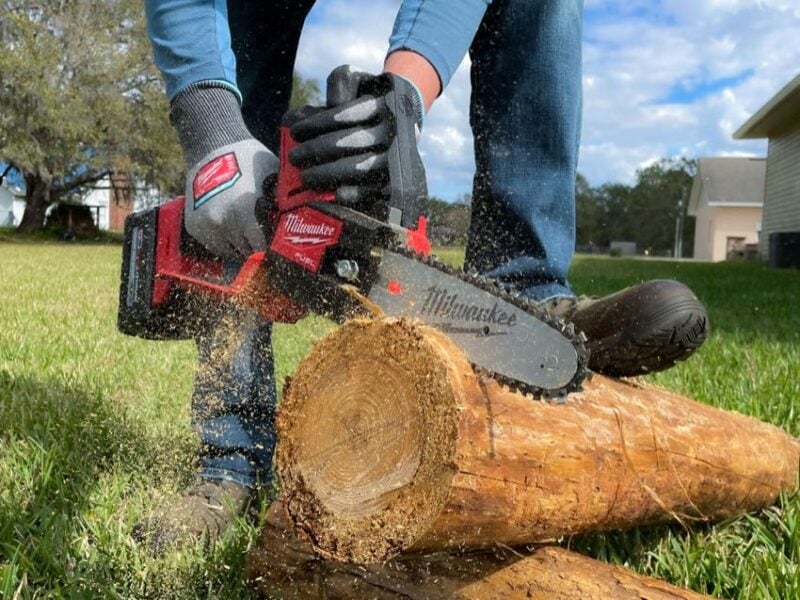
Mini chainsaws, AKA pruners, have gained a large presence in the landscaping industry thanks to their ability to handle what hedge trimmers and shear pruners can’t. At the same time, they don’t force you to pull out a full-size chainsaw. Milwaukee takes the concept to a whole new level with the 3004. Compared to the other options you have, using Milwaukee’s 25 cc gas equivalent M18 Fuel Hatchet almost feels like cheating.
As our top choice for the best mini chainsaw, its performance and 8-inch bar can be a lightweight replacement for a top-handle chainsaw on smaller sections and your go-to option for limbing and pruning branches over an inch or so. Branches smaller than that tend to be more flexible and cut better with standard pruners or a hedge trimmer.
Key Highlights
- Motor: brushless
- Bar length: 8 inches
- Weight: 5.1 lbs (bare), 7.4 lbs (with 8.0Ah battery)
- Automatic oiler
- Onboard scrench storage
- Metal bucking spikes
- Tether loop
Price: $279.00 bare
Chainsaw Saw Buying Guide – What We Look For
Power Source – Gas, Battery, or Electric?
The first thing you want to consider is what power source you’re going to use. For Pros, that’s going to be gas or battery. For homeowners, there are plenty of corded chainsaws as well.
Gas offers the strongest overall performance with the ability to use large bars for felling really big trees. The trade-off is noise, emissions, a more robust maintenance schedule, and difficulty starting when it’s not properly maintained. From a price perspective, they run the full gamut from high-value consumer models around $100 to more than $2000 for high-end Pro models.
Battery chainsaws have come a long way in performance and avoid the noise, emissions, and maintenance of a gas saw. However, they’re just now reaching the farm and ranch class in the 50 cc to 60 cc range, so they have a long way to go to replace the big gas saws. These tend to be fairly expensive for the performance level, especially when you add the cost of two or three batteries to keep you working all day.
Electric chainsaws are still the most affordable options available. They don’t have any of the gas engine issues, but most have brushed motors that eventually require brush changes. They don’t reach as high in performance as gas and battery, and you also have to manage an extension cord.
Performance
Once you know what power source you want, look for the highest performance you can get that’s still in your budget range. At the end of the day, the chain has to slice through the wood, so we typically prefer higher performance over other features.
Bar and Chains
Keep in mind that a 16-inch bar means you can only cut wood that’s under 16 inches. You can approach the cut from both sides, so your actual cutting capacity with a 16-inch bar is more like 30 inches.
Pay attention to the chain. Low-profile chains are just fine in most cases but avoid skip-tooth chains unless your saw can’t handle a standard one. Low kickback chains offer an extra measure of safety as well.
When it’s time to replace your chain, be sure to stick with the same pitch, gauge, length, and link count as the chance that came on it originally. You can purchase a chain from any manufacturer, it just needs to match the same specifications.
Bucking Spikes
Lower-performing chainsaws tend to have plastic nubs or bucking spikes. To get the best cutting action, look for saws that have metal spikes. In our opinion, the more aggressive, the better. These spikes dig into the wood and give you a solid platform for pivoting as you make your cut. It takes a lot of effort away from your arms having to fully manage the weight and movement of the saw.
Weight
Once you know a saw has the performance you need, the lighter, the better in most cases. Less weight means less fatigue while you’re working. We don’t simply want to trade metal for plastic, though. Saws with magnesium housings or aluminum front handles can drop weight while remaining durable.
Adjustments
The main adjustment you’re going to have to make on a chainsaw is the chain tension. There’s plenty of debate on tool-free vs bar nut systems and Pros tend to prefer dual bar nuts for the best security. Ultimately, it’s up to you.
If you’re going with bar nuts, look for a saw that has captured ones. These won’t fall away once they’re off the bar stud and leave you searching for it.
Some chainsaws have an adjustable oil flow as well. You typically find it on higher-end saws designed for users who can really tell the difference between when they need to increase or decrease the flow of oil on the chain.
Handle Design
The handle design on a chainsaw comes down to what feels good in your hands. The more comfortable and natural the feel, the more effectively and safely you’re likely to be using it. Everyone’s hands are different, so what feels good in your hands might not be as comfortable to your neighbor. Most of the time, it’s primarily a handle thickness consideration rather than shape.
There’s also the question of rear-handle (standard) vs top-handle designs. Top-handle chainsaws were developed for professional arborists who need to cut at height and in positions that don’t work well with a standard rear-handle design. The cutting characteristics are very different and are best for experienced users.
Trigger Style
When you’re using a chainsaw for all-day projects, the trigger can make a difference. Two and three-finger triggers spread the effort out more than a single-finger trigger does and make a difference in your hand fatigue while you cut.
Oilers
Most chainsaws on the market have automatic oilers though there are some entry-level models that still require manual oiling. Most do a fine job, though you’ll notice as you move up in quality, there are some proprietary systems to make the job of oiling more effective.
While we’re on the subject, we have yet to use a chainsaw that doesn’t leak oil. The best way to deal with it is to store your chainsaw on a piece of cardboard during the season you’re using it and drain the reservoir at the end of it.
Price and Value
Chainsaws have a wide range of prices and there are usually quality choices for just about every budget. There are trade-offs, of course. You’re not going to get Pro-level performance and durability from a $150 chainsaw. As with most products, there’s a good-better-best for every scenario. Ultimately, the best value for you is going to be based on what you prioritize the most—which is why we offer so many options in our recommendations.
Why You Can Trust Pro Tool Reviews
Ever check out a “review” site and you can’t tell if they actually use tools or if they’re just “recommending” the Amazon top sellers?
That’s not us. We only recommend what we’d actually use, even if we don’t earn a commission from it. It’s all about giving you a legitimate recommendation and our honest opinion of each product.
We’ve been in business since 2008 covering tools, writing reviews, and reporting on industry news in the construction, automotive, and lawn care industries. Our Pro reviewers work in the trades and have the skills and experience to know whether tools can perform well in the field.
Each year, we bring in and review more than 250 individual products. Our team will put our hands on hundreds of additional tools at media events and trade shows throughout the year.
We consult with innovators in the technology and design of tools to gain a broader grasp of where these products fit and how they work.
We work with more than two dozen professional contractors around the United States who review products for us on real job sites and consult with us on testing methods, categories, and weighting.
We’ll provide more than 500 pieces of new content this year absolutely free for our readers—including objective evaluations of individual tools and products.
The end result is information you can trust because of the editorial, scientific, and real-world professional experience we collectively utilize each and every time we pick up and test a tool.

